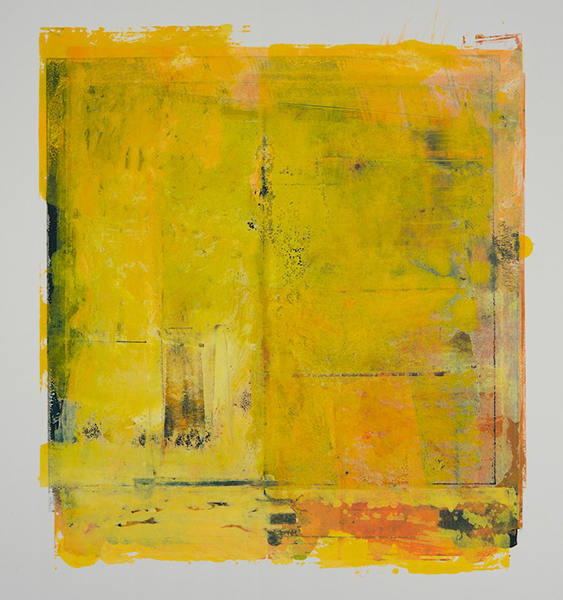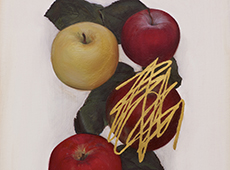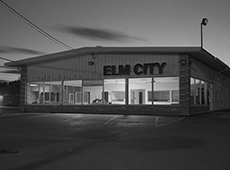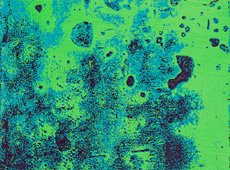Over the years, beginning in the 1990’s during those extended painting campaigns on the northwest Irish coast where the corrosive impact of weather drastically revised my own expectations of form, I’ve become much more interested in what places feel like rather than with making transcriptions of conventional appearance.

Stuart Shils, “The Last Days of Summer.”
© Stuart Shils. Image courtesy of the artist and Davis & Langdale Company, Inc.
Today I was walking down Arch street in Philadelphia and passed a construction site that I’ve been watching for more than a year, and my feeling of excitement on returning there brought to mind that memorable line from Guston, “I just had the feeling that I wanted to keep going back to the same ideas, knowing that they would be different, yet still the same.”
On the one hand it was all familiar, but on the other, as I looked through the veils of plastic fencing and construction mesh into that crazy arrangement of exposed materials and unfinished spaces, my eyes felt weak in the knees, and I thought, mmm, mmm, mmm, what a delicious place, like I’m seeing it almost for the first time and a little bit like falling in love.
Instinctively, I took out my iPhone to see what all of it looked like filtered though the camera lens. And it was so ravishingly gorgeous, compressed into a homogenous but luminous optical flatness, everything seen simultaneously as a complex pattern of light, dark and color framed within the four defining edges of the screen. Floating in the seductive immediacy of that moment I was reminded that what I want is to palpably feel the presence of it all as though light is weight and mass, to feel is as though it were taste or sound.
…I was reminded that what I want is to palpably feel the presence of it all as though light is weight and mass, to feel is as though it were taste or sound.”
So the monotypes are made in the studio, with my back facing that kind of lush experience. Unlike painting outside, the monumentality of all that information is not staring me right in the face. For some time I haven’t been painting in front of nature because it seemed important also to examine what goes on with a longer interval of time between the moment of contact and the making of a response. Instead of looking out at a motif and then turning to the canvas, perhaps I could wait say days, weeks or months before shaping a distilled response based on how that motif looked and felt sifted though the sieve of memory.
Ok, maybe the passing of time erodes some aspects of particularity, but paradoxically may also sharpen and clarify a sense of unity, impact and precision. While I’m having a quiet coffee in my neighborhood, I might daydream about a bike ride through North Philly last June in which some worn out factory walls in sun left an indelible impression; and on return to my studio begin to reconstruct what that might look like in the form of opaque and translucent layers of etching ink pressed out onto paper.
The development of these monotypes is informed by quick, mostly linear drawings made “out there” in front of things, by the residues of memory and by my own photographs that are always within reach. I’m fascinated by how the camera and iPhone work as portable graphic stenographers, and I’m thrilled to have those printed glimpses, shorthand observations that act as aide-memoire.
Over the years, beginning in the 1990’s during those extended painting campaigns on the northwest Irish coast where the corrosive impact of weather drastically revised my own expectations of form, I’ve become much more interested in what places feel like rather than with making transcriptions of conventional appearance. Curiously this impulse came not from an interest in contemporary art, but through submersion in nature while holding the brush or pencil, where it became clear to me that the game I wanted to play didn’t require faithfulness to rational or logical appearance. And that unlike in a court of law, I don’t have to put my hand on a Bible and promise to tell the truth because with regard to perception and feeling, there is no truth at the easel or in the studio other than what is invented within the tidal pull of desire.
...You forgot to enter postid in the gallery shortcode...
© Stuart Shils. Image courtesy of the artist and Davis & Langdale Company, Inc.
Stuart Shils: Recent Monotypes, opens Nov 16 and runs through Dec 21 at Davis & Langdale Company, Inc.
Editor’s Rec: Stuart Shils: Making a Monotype, part I, part II.
Read also: Neil Plotkin’s 2011 interview with Stuart Shils on Painting Perceptions, here.
Subscribe to Tilted Arc
If you like this story, please consider subscribing. We are sticklers for privacy.
We will never sell or share your e-mail address.



